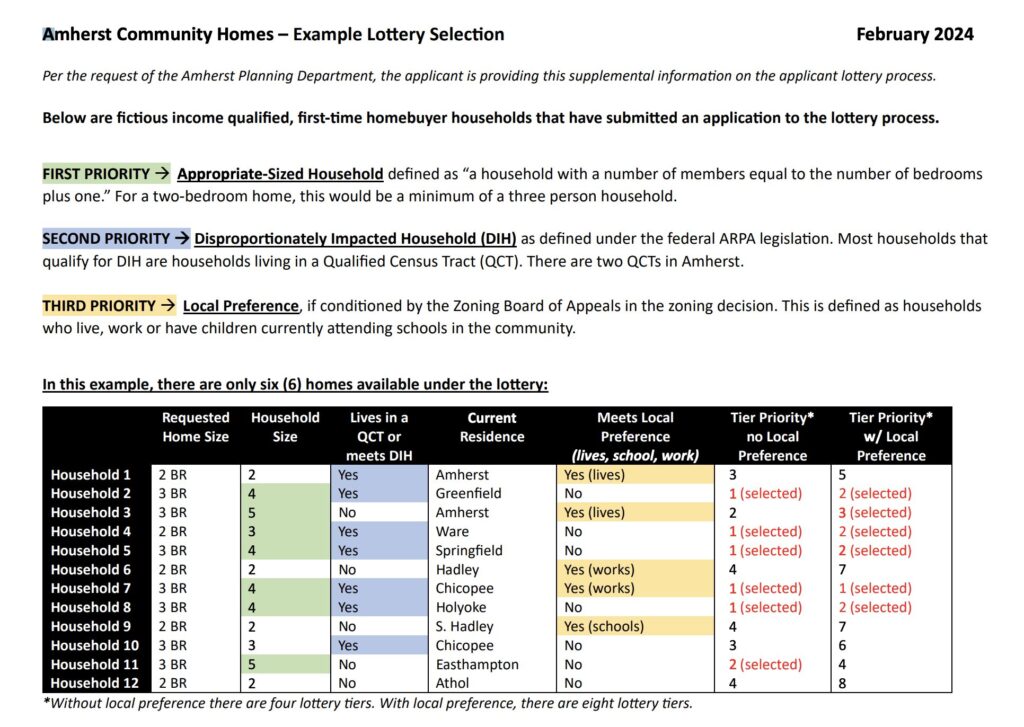EV Chargers Present Hurdle to Approval of Affordable Duplexes in North Amherst. Local Preference Still Undecided

Photo: rawpixel.com/public domain
Report on the Meeting of the Zoning Board of Appeals, February 15, 2024
Present
Steve Judge (Chair), Everald Henry, Craig Meadows, Philip White, and Hilda Greenbaum (Associate member)
Staff: Rob Watchilla (Planner), Christine Brestrup (Planning Director), Carolyn Murray (Town Attorney)
This meeting was held over Zoom and was recorded. The recording can be viewed here.
Several issues remain to be decided as the Zoning Board Appeals (ZBA) moves toward approving a proposal for 30 affordable duplex homes off Ball Lane, Amherst Community Homes, proposed by Valley Community Development Corporation. One problem is that the stretch code for energy efficiency that Amherst adopted last year requires that all of the units have the potential for electric vehicle charging. Another challenge is whether or not to adopt a preference for homebuyers who live, work, or have children in schools in Amherst. Therefore, the final decision on the project was postponed to March 14.
Stretch Code Mandates EV Chargers for Every Unit
According to Jessica Allan, project manager for Valley CDC, the state’s stretch energy code adopted by Amherst requires every newly constructed single-family home or duplex to have the possibility of an assigned EV charging space which would be metered to the unit. As a result, Valley CDC would have to install a bank of 50-amp breakers in the two parking lots, which Allan said does not make sense for this project, in part because the duplexes do not have garages or vehicle access to the units. Instead, parking is in two lots, one off Montague Road and one off Pulpit Hill Road. Because the chargers would be in parking lots, anyone could come to use them with the electricity being charged to a resident, unless they were locked..
The original plan had two EV-ready spaces for each parking lot, with the thought that the chargers would be from a commercial company, and residents would pay for charging their vehicles through the company, as they would at any public charging spot. Planning Director Christine Brestrup suggested that the conditions in the permit not specify the number of EV charging spots, and the permit could be approved while compliance with the stretch code is worked out. She noted that the project might need a variance from the state to find a reasonable solution.
It was decided that Brestrup, planner Rob Watchilla, attorney Carolyn Murray, and Allan meet to discuss a solution to the problem. ZBA member Craig Meadows suggested inviting Eversource and vendors of EV chargers to the discussion. Watchilla suggested leaving the condition out of the permit, and leaving it to the building commissioner to approve the EV charging plan as a “minor change” once a solution is found. The matter will be discussed at the next meeting.
Implications of Adopting Local Preference for Homeowners
MassHousing, the state agency that governs affordable rentals and homeownership, allows a community to designate up to 70% of units in a new development to people who live (or work) in the town or have children in its public schools. However, unlike the local preference used for the supportive studio rental units at East Gables that opened last fall, the local preference for homeownership is considered only after household size and residence in a qualified census tract or meeting requirements for a “disproportionately impacted household” (DIH). The “household size” qualification means that the number of people in the household has to be one more than the number of bedrooms in the unit. For example, a three-person household would qualify for a two-bedroom unit. A “DIH household” is a household that receives Medicaid, food assistance, or other government services. “Qualified census tract” is a designation that only applies to a handful of Hampshire County areas: North Amherst, central Amherst, and Ware. (Greenfield, Holyoke, Springfield, and Chicopee are also qualified census tracts.)
Local preference would only be considered after household size and need, so its effect could be seen as limited. Allan offered an example of the following fictitious lottery of 12 applicants for six units to explain the process.

Considering local preference creates eight tiers in the lottery instead of four.
All households will be pre-qualified for income and ability to afford the home, and households not chosen in the lottery will be placed on a waiting list.
In the sample lottery above, adding local preference as a consideration made a difference in only one of the six available units, household 3. Allan noted that a maximum of 70% of the units can be given local preference, according to state regulations.
What was still unclear to ZBA members was whether the local preference option would apply to all 30 units or only to the 10 available to households with incomes of 80% or less of the area mean income (AMI). (The remaining 20 units are available to households making up to 100% of the AMI.) Neither the ZBA nor Allan could say whether the 70% maximum of units where local preference could be applied means 7 units or 21 units. Allan said she would clarify this with MassHousing.
Most of the ZBA members were in favor of establishing local preference. Hilda Greenbaum noted that many towns near Amherst do not have the 10% minimum inventory of affordable housing recommended by the state, and said that Amherst residents should get preference for Amherst’s affordable housing stock. Brestrup added that, because more than 10% of Amherst housing is affordable, residents might want projects like this to benefit residents.
Meadows said that he knows several current or former Amherst residents who can’t find housing here that they can afford. However, ZBA member Everald Henry voiced some misgivings, saying that Amherst is a predominantly white town and that one of the aims of this project is to open more homeownership to BIPOC people. He felt that adopting the local preference option would not help counteract the historic disparity between the BIPOC population and the white population in housing. Allan assured him that Valley CDC plans intensive outreach and financial literacy education to encourage BIPOC applicants.
What Constitutes a Household?
Greenbaum asked for clarification about what constitutes a household and how household income is determined. Allan said that if an applicant is pregnant at the time of the application, the unborn baby would be considered in the size of the household. However, she was unsure about unrelated applicants, such as three friends applying for a two-bedroom unit. She said she will check with MassHousing about these questions, too. She also said that Valley CDC will use a monitoring agent to handle the sales of the units and assure that the proper guidelines are followed.
Public Comment
Grover Wehman Brown, a member of the Amherst Municipal Affordable Housing Trust, said that they and the trust are very enthusiastic about this project, and hope that the ZBA will work with Valley CDC to keep the cost of the units down. They added that in their 15 years working with affordable housing, they have seen the need rise every year.
The ZBA needs more information about the EV charging, the definition of a household, and whether local preference applies to all of the units or only those at 80% AMI. Other details that need to be finalized include the separation of the flag lot for the existing Ball Lane home that Valley CDC plans to sell separately, at market rate. The ZBA will continue its hearing on Amherst Community Homes to March 14 at 6 p.m., after it goes before the Conservation Commission on February 28. The ZBA must make its decision regarding the permit before April 16.
